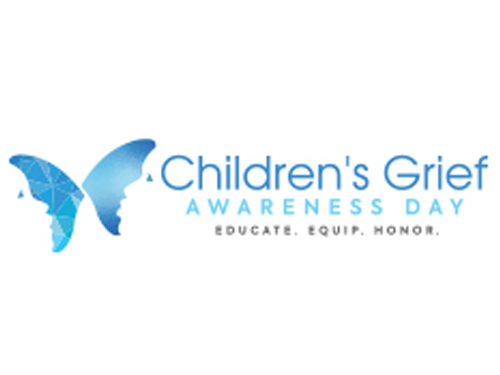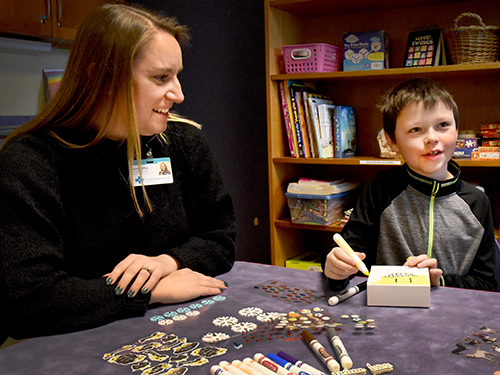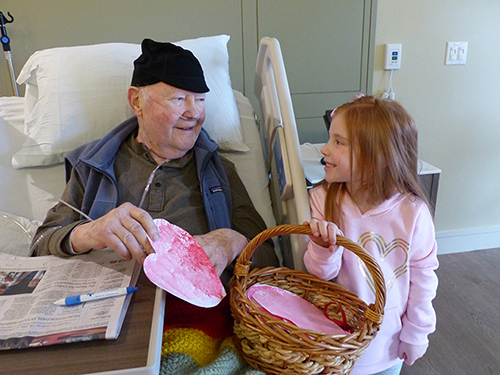How can we help?
888-283-1722
Call us now at 888-283-1722
24/7 Referrals and Nursing Support
Voices of Care Blog

Children's Grief Awareness Month: Why it Matters
Posted on October 28, 2025 by Kasey Griffin, MS, CCLSWhen a child experiences loss, their world changes. But too often, the world around them doesn’t seem to notice. Grief in childhood can be quiet and confusing. It can look like anger, distraction, silliness, or even nothing at all. But underneath, there’s a deep need to be seen, understood, and supported.
Every November, we recognize Children’s Grief Awareness Month – a time dedicated to acknowledging the unique experiences of grieving children and teens and reminding them that they are not alone. It’s also an opportunity for all of us to learn how to better support the young hearts navigating loss.
What is Children’s Grief Awareness Month?
Children’s Grief Awareness Month grew out of Children’s Grief Awareness Day, founded in 2008 by the Highmark Caring Place, a center dedicated to supporting grieving children, adolescents, and their families. The month is symbolized by the blue butterfly, representing hope, transformation, and remembrance. Throughout November, communities, schools, and families come together to increase understanding of childhood grief, spark conversations, and create spaces of compassion for children coping with loss. The goal is simple but powerful: make sure every grieving child feels seen, heard, and supported.
Why it Matters
-
Statistics show this is a widely shared experience.
According to the 2025 National Childhood Bereavement Estimation Model (CBEM) Report, 1 in 11 children in the U.S. will experience the death of a parent or sibling by age 18. That’s nearly 6.4 million youth. By age 25, more than 15.5 million young people will have experienced this kind of loss.
These numbers remind us that children’s grief is not rare, but a deeply widespread reality calling for attention, care, and action. -
Children grieve differently from adults.
While adults often express grief through words and reflection, children show their grief through behavior and play. A child might talk about the loss in one moment and then run off to play in the next; it’s a healthy coping mechanism called “puddle jumping.” Grief for children is not constant, but it is ever-present. -
Unacknowledged grief can leave lasting scars.
When children’s grief is minimized or overlooked, it can impact their emotional development, mental health, and ability to trust. They may feel isolated or confused, wondering why their feelings don’t seem to “fit” what others expect. -
Community support makes all the difference.
When caring adults take the time to listen, validate, and create safe spaces, children begin to understand that their feelings are normal and that they don’t have to grieve alone. This simple act of presence builds resilience and fosters healing that lasts a lifetime. In fact, the CBEM report found that 97% of teachers believe grief adversely impacts student learning. It’s a reminder that support in schools and communities is critical for children’s healing and success.
What Grieving Children Need
Every child’s grief is unique, but most need the same core things:
- Honest, age-appropriate information: Children deserve truthful answers that match their developmental level.
- Safe spaces to express emotions: Whether through art, play, talking, or movement, expression helps release what words can’t always hold.
- Consistency and routine: Familiar rhythms can provide comfort during uncertain times.
- Connection: Grieving children heal through relationships with family, peers, and supportive adults.
- Opportunities to remember: Sharing stories, making memory boxes, or celebrating birthdays and anniversaries help keep loved ones close in meaningful ways.
How We Can All Help
You don’t have to be a grief professional to make a difference. Here are simple ways to support grieving children and to honor Children’s Grief Awareness Month:
- Wear blue on the third Thursday in November to show your support.
- Start conversations about grief with children and teens in your life.
- Listen without fixing. Sometimes the most powerful thing we can do is simply sit beside a child in their sadness.
- Share resources from organizations that support grieving families, such as the Dougy Center or the National Alliance for Children’s Grief.
- Donate or volunteer with local grief programs, schools, or child life teams.
Grief is not something to get over – it’s something to carry, and children should never have to carry it alone. Every blue butterfly, every conversation, every small act of kindness reminds grieving children that their love and loss do matter.
This Children’s Grief Awareness Month, may we all pause to honor the young hearts who are learning to live with loss, and commit to walking alongside them with empathy, patience, and hope.
At Care Dimensions, we specialize in helping children mourn and cope with death – preparing them prior to the loss and supporting them after. Our children’s program provides emotional support to patients and families, and also supports children in the community. Learn more at CareDimensions.org/Children. You can also contact the children’s program team at 855-774-5100 or email [email protected].
About the Author:
Kasey Griffin is a Certified Child Life Specialist within the Children’s Program at Care Dimensions.
Additional Posts
Memory Making Activities for Children Before and After a Death
Posted on November 17, 2025 by Bridget McHallam, Child Life Specialist Intern in ChildrenFor many children and teenagers, engaging in memory-making activities can be a meaningful way to express love, connection, and remembrance. Here are some suggested activities. ...
Continue readingActivities that Help Grieving Children and Teens
Posted on November 14, 2024 by Sarah Bujold, MS, CCLS, & Jason Abrams, Child Life Practicum Student in ChildrenChildren and teens often benefit from creative activities that allow them space to process their feelings, develop coping skills, and remember the person who died. ...
Continue readingHow to Support Your Child When Visiting a Hospice Patient
Posted on March 6, 2024 by Care Dimensions Children’s Program Staff in Children, HospiceCare Dimensions child life specialists offer tips for parents to prepare their children for visits with loved ones who are receiving hospice care. ...
Continue readingAnyone—patient, family, care provider—can make a referral. Fill in the form online or call us today.
Since 1978, Care Dimensions, formerly Hospice of the North Shore, has provided comprehensive and compassionate care for individuals and families dealing with life-threatening illnesses. As the non-profit leader in advanced illness care, we offer services in over 100 communities in Massachusetts.
Copyright 2025 | Care Dimensions, 75 Sylvan Street, Suite B-102, Danvers, MA 01923 | 888-283-1722 | 978-774-7566 |









